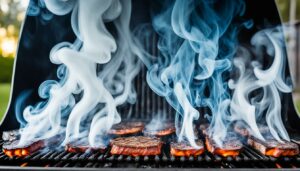Barbecue is popular around the world, but few culinary techniques are as beloved as low and slow smoking.
Masters of this art form can turn brisket and ribs into delicacies that are cherished by foodies from coast to coast.
While often associated with Southern-style cooking, smoked meats and veggies have become increasingly popular around the world. This article examines the art of low and slow smoking, techniques and equipment, spices, rubs, and marinades, and the best woods for delicious smokey flavors.
How to Low and Slow Smoke Meat
One of the most common questions that people have about low and slow smoking is, “What equipment do I need to get started?”
In general, you need two things: a smoker and a fuel source.
Smokers come in many shapes and sizes, but the most popular designs include offset smokers, vertical smokers, and drum smokers.
Fuel sources for smoking meat include hardwoods like oak, hickory, and fruitwoods like apple, peach, and cherry.
Overall, low and slow smoking involves cooking meat at low temperatures, around 225 to 250 degrees Fahrenheit, for several hours to produce moist, tender, and perfectly smoky results.
Benefits of Low and Slow Smoking
People are often curious about the benefits of low and slow smoking. There are many, from producing tender meat that is infused with delicious smoky flavors to creating healthy dishes that are low in fat and calories.
Low and slow smoking also helps to preserve food, giving you the ability to cook large cuts of meat over long periods of time without worrying about spoilage.
Additionally, low and slow smoking can help to bring out the natural flavor of meat, helping you to create dishes that are both tasty and nutritious.
Techniques for Smoking Meat
When it comes to perfecting your low and slow smoking technique, there are several tips to keep in mind. One of the most important is to give yourself enough time.
Smoking meat is not a quick process, and you need to be patient and willing to devote several hours to the task.
Additionally, you need to be sure to trim off any excess fat or connective tissue before smoking.
This will help to prevent the meat from becoming dry and chewy.
Finally, be sure to use a meat thermometer to ensure that the meat reaches a safe internal temperature.
The Best Wood for Smoking Meat
When it comes to getting the best flavors in your smoked meats, the type of wood that you use can make a big difference.
For example, hickory is a popular choice for smoking pork, while mesquite is often used for smoking beef. Other popular woods include oak, cherry, and pecan.
Ultimately, the choice of wood is a matter of personal preference, and you should experiment to find the best flavors. Keep in mind that different woods can produce varying levels of smoke, and you should use only food-grade woods that are free of chemicals and glues.
Low and Slow Smoking for Beginners
If you’re new to the world of low and slow smoking, you may feel a bit overwhelmed at first. Fortunately, there are many resources available to help you get started.
One of the best ways to learn more is to read up on the different equipment and techniques that are used in smoking. You can also watch videos online or attend classes on BBQ and smoking.
Ultimately, the best way to learn is through trial and error. To make the process more enjoyable, consider inviting friends and family over for a barbecue and sampling different smoked meats!
Low and Slow Smoking for Competition BBQ
Low and slow smoking also has a competitive aspect. BBQ competitions are held all around the world, with prizes going to the best-smoked meats and BBQ dishes.
At these events, competitors use a variety of smoking techniques and rubs to produce uniquely flavored dishes that are judged on their tenderness, flavor, and overall appearance. If you’re interested in competing in BBQ, there are several things to keep in mind.
These include finding the right equipment and fuel sources, studying the different techniques used to smoke meats, and experimenting with different spices and rubs.
Low and Slow Smoking for Flavor
Smoked meats can have a unique and unforgettable flavor that is difficult to replicate with other kinds of cooking.
To get the most delicious smoked meats, consider using traditional spices and rubs, such as salt and pepper, garlic, and paprika, as well as adding unique ingredients like coffee, honey or fruit juices to impart different depths of flavor.
Although meats are the most popular food to smoke, there are many other foods that are worth a try, including vegetables and even cheese.
Low and Slow Smoking Equipment
Low and slow smoking requires specific equipment. The most popular options include offset smokers, vertical smokers, and drum smokers.
You should go for quality smokers that are durable, rust-resistant, and offer temperature control. Investing in digital meat probes to keep track of the temperature inside the smoker and the meat itself will help monitor the smoking process. Additionally, make sure to have enough wood chips or pellets for fuel and a sturdy set of utensils for handling and flipping meat.
Low and Slow Smoking Recipes
Finally, no discussion of low and slow smoking would be complete without mentioning recipes.
Smoked brisket, pulled pork, chicken, and ribs are all classics that many people love to prepare and eat.
However, there are also plenty of less-traditional smoked dishes that are worth a try, like smoked salmon or smoked tofu.
To get the best results, be sure to try different seasoning blends, marinades, and wood combinations until you find the flavors that you enjoy the most.
In conclusion, low and slow smoking is an art that can produce some of the most tender and delicious meats and vegetables that you will ever taste. With the right equipment, spices, and techniques, you can become a master of this art form and find a new appreciation for the flavors of smoke.
FAQs
1. Is low and slow smoking healthy?
Yes, low and slow smoking can be healthy when prepared using lean sources of protein and adding flavor through spice, rather than large quantities of salt, sugar and saturated fats.
2. Can you use any kind of wood for smoking meats?
No. You should only use food-grade wood that’s free of chemicals and additives, such as fruitwoods, hickory or oak.
3. What temperature range should I maintain when smoking meat?
Smoking meats at temperatures between 225 to 250°F for several hours produces tender and perfect smoky chunks.
4. What’s the best meat to smoke for a beginner?
Pork shoulder is one of the most popular meats to smoke for beginners.
5. Can you infuse smoky flavors into non-meat products?
Yes, vegetables, fruits, and cheese can be smoked for added smoky flavors.





